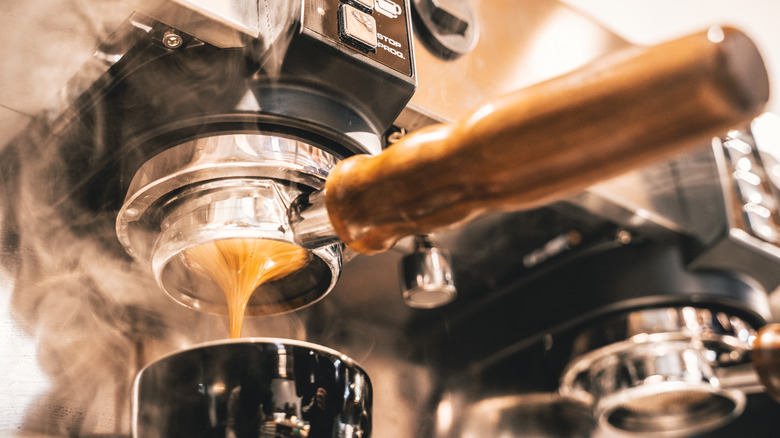How Often Should You Really Be Cleaning Your Espresso Machine?
We may receive a commission on purchases made from links.
The appeal of sipping a warm, foamy latte without stepping foot outside of the house is difficult to deny. It's an easy way to avoid spending $8 every morning on that oat milk cappuccino from the café down the street. Although "easy" might not be the right word here. Anyone who's ever worked in a coffee shop knows that crafting a killer espresso drink is an art that takes time and practice to master. For non-pros, fat-fingering the pour isn't even one of the more devastating mistakes with making espresso at home. Messing up the grind size, improper tamping technique, and over-extraction can all lead to an undrinkable shot of bitter or horribly watered-down espresso. But what does it mean if your shot tastes a little stale or gritty?
It might not be you — it could be your machine. (Technically, it's still you for not cleaning your appliance properly, but we digress.) Regularly cleaning your espresso machine makes your coffee taste better and protects your appliance's longevity. Breville Coffee Specialist Ryan McLachlan says cleaning is one of the critical things that separates a home user from a professional barista (and, subsequently, from a delicious beverage). Leftover grounds and coffee oils build up in the portafilter and group head, and can ruin espresso's delicate flavor. So, how often should you clean your espresso machine?
Clean often, starting with the portafilter
To keep your appliance in good working condition and your espresso tasting bright and fresh, it's important to purge and backflush the machine and wipe down the steam wand before and after each espresso. But you also need to clean your machine every week it gets used. If you're making at least two lattes a day, that espresso machine needs to be deep cleaned at the end of the week as part of routine upkeep. A machine that's pulling shots all day in a café, however, will want to bump a full cleaning up to once a day.
Either way, a proper cleaning starts with the portafilters. Cafiza cleaning powder by Urnex is the best tool for the job. It's an odorless white powder, but don't get it twisted — this is a powerful substance. (Take note: after it strips your espresso machine squeaky clean with near-magical efficiency, Cafiza leaves a slight residue behind. Be sure to wash this off before making a beverage.)
To clean your portafilters, eyeball a teaspoon of Cafiza and scoop it directly into your milk-steaming pitcher. Then, fill the pitcher about halfway full with hot water straight from your espresso machine. Take the basket out of the portafilter, unscrew the dispersion screen, and fully submerge all the pieces in the pitcher full of hot water and dissolved Cafiza. (Portafilter, basket, screen, and screw.) Now, set this whole thing aside — it's time to turn your attention to the group head.
Get your group head in the game
Espresso machines come with a "blind" portafilter basket specifically intended for cleaning the group head. These portafilters don't have drainage holes, making them similar to a butterfly net with an iron basket. To clean your group head, grab your Cafiza, eyeball about a ¼ teaspoon of the powder, and scoop it into the blind basket. Then, lock your portafilter into place in the group head in the same way you typically would when pulling a shot. Only, this time, press the button allowing water to fill the group head and cut it off after about five seconds. This will submerge the group head in hot water and the dissolved Cafiza to soak off any trapped coffee grounds or oils. After a few minutes of soaking, dump out the portafilter and run two more cleaning cycles with just hot water to make sure all the cleaning product is washed away and your appliance is food safe. To the same effect, be sure to scrub your milk pitchers and portafilters extra thoroughly after the Cafiza soak is done.
After your cleaning is complete, reassemble your machine and dial in your grind. If for some reason, you're still sipping sour or gritty shots, it might be time to replace your dispersion screen, which can wear out over time.


